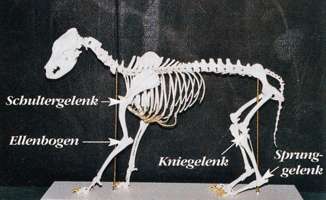OCD (Ostechondrosis dissecans).
"Bone cartilage disease '
Formation
In order to understand the origins of OCD, one must first know how bone grows. The bone grows in the cub, both in the growth plates, and in the area of the joint surfaces. In the growth plates and the joint surface cartilage cells arise by cell division. These are the course of development in bone cells converted.
OCD in the area of joint surface is formed so that the cartilage cells divide very quickly and Verknöcherungsvorgang slowly progressing. The articular cartilage becomes very thick. Because cartilage has no blood vessels, it is the joint lubricant supplied with nutrients ago. In a very thick articular cartilage insufficient, the cartilage cells, which at the farthest away from the joint supplied with nutrients. They die. The articular cartilage is therefore no longer be associated with the underlying bone and is released from the bone. In addition, cracks in the joint cartilage, synovial fluid between cartilage and bone which can penetrate through. The articular cartilage is completely replaced. The detached cartilage disk can either remain on site, or even in the joint "walk". This is called a joint mouse. In each case, degradation products of dead cartilage cells are released and the cause of inflammation with pain in the affected joint. Only now does a lameness. If the cause of the disease is not treated, will pass the infection and is chronic. As a result, developed arthritis, that is a degenerative joint disease. There is new bone formation in and around the joint. These changes are reversed to make not more, and it creates a permanent damage to the joint.


Symptoms and the affected joints
OCD leads, especially among young dog aged four to twelve months to lameness. It often ill dogs, very fast growing and in comparison with peers are more difficult. OCD is more common in male than female dogs for. It is used in all races found before that in adults a weight of 25 kg or more.Some of the commonly affected breeds are Labrador and Golden Retriever, the Rottweiler, the German Great Dane, the St. Bernard, the German Shepherd Dog and the Bernese mountain dog. However, it is almost all the big dogs, even races in OCD suffer so. Another point that the weight plays a role in addition, the physical activity of the dog.The more active the dog is young, the greater the burden Damaged cartilage structures, the more likely it is for the replacement of articular cartilage or bone to cancel extensions. The predisposition to the illness of OCD is inherited, as certain racial lines accumulated the same illness in OCD. Affected joints are mainly the shoulder, elbow, knee and ankle.

Prepared by the Rhodesian Ridgeback breeders:
Mashambani

& Mhangura
